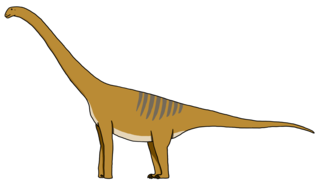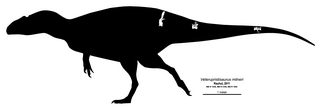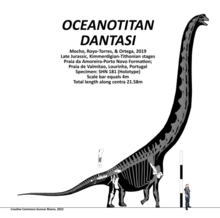
Camarasaurus was a genus of quadrupedal, herbivorous dinosaurs and is the most common North American sauropod fossil. Its fossil remains have been found in the Morrison Formation, dating to the Late Jurassic epoch, between 155 and 145 million years ago.

Torvosaurus is a genus of large megalosaurine theropod dinosaur that lived approximately 165 to 148 million years ago during the Callovian to Tithonian ages of the late Middle and Late Jurassic period in what is now Colorado, Portugal, Germany, and possibly England, Spain, Tanzania, and Uruguay. It contains two currently recognized species, Torvosaurus tanneri and Torvosaurus gurneyi, plus a third unnamed species from Germany.

Bothriospondylus is a dubious genus of neosauropod sauropod dinosaur. It lived during the Late Jurassic in England, and the type and only species is B. suffossus.
Dracopelta is a monospecific genus of ankylosaur dinosaur from Portugal that lived during the Late Jurassic in what is now the Lourinhã Formation. The type and only species is Dracopelta zbyszewskii, which is represented by a partial skeleton including unpublished material.

Dinheirosaurus is a genus of diplodocid sauropod dinosaur that is known from fossils uncovered in modern-day Portugal. It may represent a species of Supersaurus. The only species is Dinheirosaurus lourinhanensis, first described by José Bonaparte and Octávio Mateus in 1999 for vertebrae and some other material from the Lourinhã Formation. Although the precise age of the formation is not known, it can be dated around the early Tithonian of the Late Jurassic.

Lusotitan is a genus of herbivorous brachiosaurid sauropod dinosaur from the Late Jurassic of Portugal and possibly Spain.

Lourinhasaurus is an extinct genus of herbivorous sauropod dinosaur genus dating from Late Jurassic strata of Estremadura, Portugal. The genus is monotypic, containing one species, Lourinhasaurus alenquerensis. The type specimen for this species was discovered near the town of Alenquer, near an abandoned mill. The specimen is housed at the Geological Museum of Lisbon.
Galvesaurus, or Galveosaurus, is a genus of brachiosaurid sauropod dinosaur from the Late Jurassic period. Fossils of the only known species, G. herreroi, were found in Galve, Spain, hence its generic name, "Galve lizard". The specific name G. herreroi honours the discoverer, José María Herrero. Some researchers suggest that the taxon might represent a junior synonym of Lusotitan.

Camarasauridae is a family of sauropod dinosaurs. Among sauropods, camarasaurids are small to medium-sized, with relatively short necks. They are visually identifiable by a short skull with large nares, and broad, spatulate teeth filling a thick jaw. Based on cervical vertebrae and cervical rib biomechanics, camarasaurids most likely moved their necks in a vertical, rather than horizontal, sweeping motion, in contrast to most diplodocids.

The Lourinhã Formation is a geological formation in western Portugal, outstanding for its abundant fossilized fauna and flora, including dinosaur bones, dinosaur eggs and nests, and fossil tracks, to name but some examples.
At its upper limit, the formation includes some Early Cretaceous (Berriasian) strata, but it mostly consists of Late Jurassic (Kimmeridgian/Tithonian) rocks. The stratigraphy of the formation is generally complex and controversial, with the classification and grouping of its lithostratigraphic units varying between different stratigraphers.
The fossil biota present there is very similar to that of the Morrison Formation in the United States and, to a lesser extent, the Tendaguru Formation in Tanzania. There are also similarities to the Villar del Arzobispo Formation in Spain, and the neardy Alcobaça Formation.
The formation is named after the municipality of Lourinhã, the geographic area it mostly occupies.
The Alcobaça Formation, previously known as the Guimarota Formation and also known as the Consolação Unit, is a geological formation in Portugal. It dates back to the Kimmeridgian stage of the Late Jurassic. It is an important source of information on the diversity of Late Jurassic mammals. Many of the fossils were collected from the now disused and flooded Camadas de Guimarota coal mine.
The Arcillas de Morella Formation is a geological formation in Spain whose strata date back to the Barremian stage of the Early Cretaceous. Dinosaur remains are among the fossils that have been recovered from the formation.

The Villar del Arzobispo Formation is a Late Jurassic to possibly Early Cretaceous geologic formation in eastern Spain. It is equivalent in age to the Lourinhã Formation of Portugal. It was originally thought to date from the Late Tithonian-Middle Berriasian, but more recent work suggests a Kimmeridigan-Late Tithonian, possibly dating to the Early Berriasian in some areas. The Villar del Arzobispo Formation's age in the area of Riodeva in Spain has been dated based on stratigraphic correlations as middle-upper Tithonian, approximately 145-141 million years old. In the area of Galve, the formation potentially dates into the earliest Cretaceous.

Arkharavia is a dubious genus of somphospondylan sauropod, but at least some of the remains probably belong to a hadrosaurid. It was discovered in the Udurchukan Formation in Russia and lived during the Late Cretaceous. It was described in 2010 by Alifanov and Bolotsky and the type species is A. heterocoelica.

Veterupristisaurus is an extinct genus of carcharodontosaurid theropod dinosaur known from the Jurassic of Tendaguru, Lindi Region of southeastern Tanzania.
Eousdryosaurus is a genus of basal iguanodontian dinosaur known from a partial skeleton discovered in Upper Jurassic rocks in western Portugal. The type, and only species, is Eousdryosaurus nanohallucis, named and described in 2014.

Lusovenator is a genus of carcharodontosaurian theropod dinosaur, from the Late Jurassic (Kimmeridgian) Praia de Amoreira Porto-Novo Member and the Late Jurassic-Early Cretaceous (Tithonian-Berriasian) Assenta Member of the Lourinhã Formation in present-day Portugal. It includes one species, Lusovenator santosi.

Narindasaurus is a genus of turiasaurian sauropod dinosaur from the Middle Jurassic Isalo III Formation of Madagascar. The type species, N. thevenini was formally described by Royo-Torres et al. in 2020. The holotype, which consists of one specimen, is currently stored at the Muséum national d’Histoire naturelle and has been since 1906 or 1907.

Garumbatitan is an extinct genus of somphospondylan sauropod dinosaur from the Cretaceous Arcillas de Morella Formation of Spain. The genus contains a single species, G. morellensis, known from multiple partial skeletons.



























